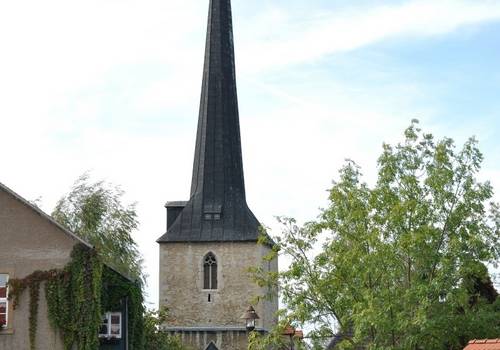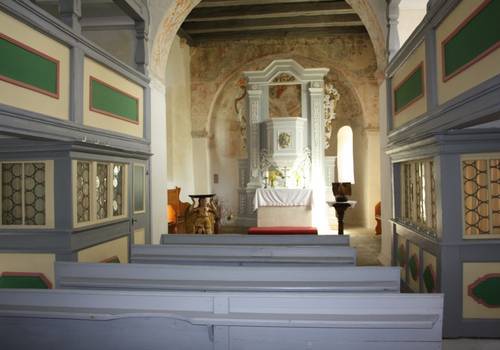St. Lucy’s Village Church in Flemmingen
Flemmingen’s church was originally built as a Romanesque church with a choir tower. Constructed in around 1200, the exterior is largely well preserved. The tower’s height was only increased in 1508, and the pointed spire, visible from far away, was added. The tracery windows in the tower commemorate this. Furthermore, in the 18th century, the height of the nave was increased, as more space was needed inside for the galleries. New rectangular windows were added, and the Romanesque windows were bricked up. The south side features a noteworthy Romanesque columned portal with cube capitals and palmette decorations in the tympanum. The north side also featured a portal, with a circular cross in the tympanum, still recognisable today.
The internal furnishings of the church are entirely 18th century. A mirrored ceiling spans the church interior. A double horseshoe gallery, a pulpit altar (1739-42), a pelican lectern (1720) and a baptismal font (1719) characterise the Baroque style of the church. The west gallery hosts an organ by Carl Winter (Zeitz) from 1852. The most notable features of the church are the late Romanesque paintings in the apse and in the choir, which feature Christ in the mandorla, angels, and depictions of the saints, including the apostles and Saint Sebastian.
The church was most likely dedicated to Saint Lucy. The saint from Syracuse was executed in around 310. In her martyrdom, her eyes were gouged, and she thus became the patron saint of eye complaints, but she was also worshiped by farmers.
Opening hours:
1st April – 31st October, Saturdays and Sundays from 10am to 6pm. Admission free, donations invited
Guided tours available on request/by appointment. Please call Mr. R. Knauf, Tel. 03445 77 52 80

![25 Jahre Siegel - Offi Seite [(c)Administrator]](https://www.strassederromanik.de/de/datei/anzeigen/id/79750,1050/25_jahre_siegel.png)

